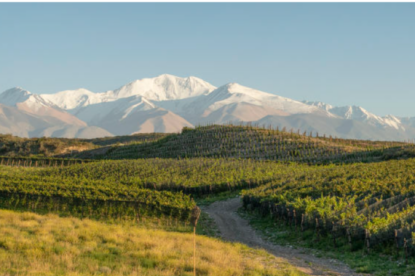Largely centered in the southwest of the country, Germany’s 13 wine growing regions represent a diversity of terroir along the northern limits of wine growing. Yet within Germany, there are certain vineyards that are simply legendary. The wines produced there are iconic expressions of geological and human histories. They smell, taste and feel unlike wines from anywhere else.
Identified over centuries of human trial and error, these great vineyards represent the perfect convergence of conditions – climate, soil, sun exposure and topography – ideal for each particular grape variety. This hyper specificity of terroir is key to overcoming challenges of cool-climate viticulture and producing wines of greatness, vintage after vintage.
Explore five of these legendary German vineyards below.
Bremmer Calmont, Mosel
Overview: Rising 68 degrees from the Mosel River above the village of Bremm, the vertigo-inducing Calmont is among the steepest vineyards in the world.
History: The oldest documented evidence of viticulture at the Bremmer Calmont is credited to a poem written around the year 588 by Venantius Fortunatus, noting the “rock itself giveth birth and wine gushes from it.”
Distinctions: Covered with shards of sandstone, quarzite and slate, the perilous, labor-intensive site provides an ideal microclimate for wine growing. Its south-facing, steep stone terraces form a natural amphitheater that absorb sunlight and radiate heat. Planted almost entirely with Riesling, the vineyard produces intensely ripe wines with bold, often tropical, fruit flavors and dazzling smoke and herbal complexities.

Producers offering wine from Bremmer Calmont:
Rotenfels, Nahe
Overview: Germany’s highest scarp face north of the Alps, the Rotenfels rises over 1,000 feet above the Nahe River between the villages of Norheim and Bad Münster am Stein-Ebernburg.
History: Born from a volcanic eruption 270 to 260 million years ago, the Rotenfels was cut from centuries of weathering and erosion by the Nahe River.
Distinctions: Riesling grows exclusively upon this precipice of red volcanic stone. The south facing cliffs form a canyon that retains heat and bathes vines in sunlight, while protecting them from cold winds. This warm, dry microclimate yields early-ripening vines and plump, fruity wines with complexities of spice and smoke.

Producers offering wine from Rotenfels:
Dr. Crusius, Gut Hermannsberg, Rapp
Roter Hang, Rheinhessen
Overview: The Roter Hang slope is a three-mile expanse of red clay and sandstone along the Rhine River between the villages of Nierstein and Nackenheim, located at 50° Northern latitude. The area takes its name from the iconic geological formation of red stone which extends over 2,500 feet deep into the ground.
History: The Roter Hang is Rheinhessen’s historic jewel – its wines praised as among the best in the world by Faust in Goethe’s 19th century masterpiece.
Distinctions: Formed 280 million years ago, the sandstone massif absorbs heat and amplifies sunlight reflected from the Rhine – an optimum environment for Riesling, which makes up 95% of the area’s plantings. The perfect amount of vine stress in this nutrient poor, dry soil produces exceptionally ripe and full-bodied wines that are aromatic and distinctly mineral.

Producers offering wine from Roter Hang:
Gunderloch, Louis Guntrum, Georg Gustav Huff, Schneider Müller, Strub
Rüdesheimer Berg, Rheingau
Overview: The verdant slopes of the Rüdesheimer Berg encompass 240 acres of vineyards sweeping along the Rhine River in the heart of the Rheingau.
History: A panoramic hill edged by medieval villages, Rüdesheimer Berg is guarded over by ruins of Ehrenfels Castle, a citadel and customs post dating back to the year 1000.
Distinctions: Arching almost entirely south at a gradient of up to 60 degrees, the sun-drenched slate and quarzite slope is one of the warmest areas in the Rheingau. It’s famed for exceptionally age-worthy, finessed Riesling – usually dry and boasting penetrating peach and apricot notes. Riesling makes up 90% of plantings here, but its Pinot Noir is also legendary.

Producers offering wine from Rüdesheimer Berg:
Allendorf, August Kesseler, Balthasar Ress, Breuer, Corvers Kauter, Dr. Naegler, Geheimrat J. Wegeler, Johannishof, Kloster Eberbach, Leitz, Schloss Schönborn
Würzburger Stein, Franken
Overview: Rising from the banks of the Main River and overlooking the city of Würzburg, the Würzburger Stein is Germany’s largest single-vineyard site and one of its oldest.
History: Wine has been cultivated here as far back as 779. An unopened Steinwein from 1540 still remains in the cellar of the Bürgerspital, a winery and charitable estate.
Distinctions: The Stein is most known for Silvaner, first planted by Cistercian monks in 1665. Its south facing, muschelkalk, or shell-limestone, slopes are warmed by the river and produce full-bodied, richly textured white wines. The region’s best wines are typically bottled in bocksbeutel, the distinctly squat, flat-bellied bottles traditional to the region.

Producers offering wine from Würzburger Stein:
Am Stein, Bürgerspital, Christian Reiss, Juliusspital, Staatlicher Hofkeller
Last Updated: May 8, 2023














